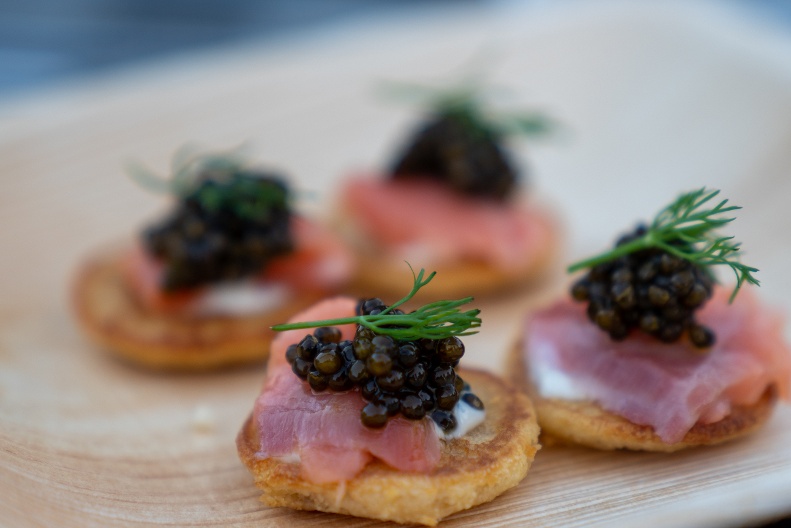Caviar, the salted roe of sturgeon, is considered a delicacy worldwide. It is traditionally obtained from wild species caught mainly in the Caspian Sea, and is prepared by sieving their egg masses, and adding 4-6% salt as a preservative and flavour enhancer. Demand for caviar, and the prices it obtains, is high, but supplies may be running out.
The trouble is that caviar is typically produced from unripe, unovulated sturgeon eggs, which can only be harvested by sacrificing fish. Sturgeon are slow growing creatures that may take 20 years to reach sexual maturity (depending on species) and, even then, do not spawn every year.
In the absence of adequate management systems, particularly since the decline of the USSR, they have been harvested faster than they can reproduce, resulting in their near extinction. Twenty-seven species are on the IUCN Red List of Threatened SpeciesTM and of these, 63% are listed as critically endangered. Sturgeon have also been listed in Appendix II of the United Nation's Convention on International Trade of Endangered Species of Wild Fauna and Flora (CITES) since 1998. This limits the international trade of sturgeon and their products, but the slow maturation of the fish means that populations could take many years to recover. The use of wild sturgeon for caviar production is not sustainable.
Alternatives are available though. Imitation caviar is the name given to roe from fish other than sturgeon (e.g. capelin, lumpfish, salmon) which are consumed as caviar. The eggs from these fish are processed like authentic caviar, but may also be seasoned and coloured.
Although the resulting products may be delicious in their own right, they are usually quite different from sturgeon caviar. Beluga caviar consists of pea-sized, black-grey eggs which burst in the mouth releasing a smooth, buttery flavour. Salmon eggs, in comparison, are orange-red, larger in size and taste strongly of salmon; they do, however, offer a similar "popping" mouthfeel. In contrast, lumpfish and capelin caviars comprise much smaller eggs, which may be dyed black, but are crunchy and briny or chewy and mild, respectively. There are, of course, many other substitutes, with varying qualities, but what if only the "real thing" will do?
Sturgeon aquaculture is proving to be valuable on two counts - replenishing wild stocks which may not be able to recover on their own, and ensuring a regular supply of caviar to meet consumer demand. There are challenges to overcome, however; not least the limited supplies of broodstock and the long maturation period. With a typical wait of 5-10 years before a female reaches maturity and produces eggs under culture conditions, it is simply not efficient to farm sturgeon for just one egg harvest as would be traditional.
Fortunately, whilst it is conventional to sacrifice sturgeon to obtain their eggs, it is not essential. Roe can be harvested from live sturgeon through a caesarean-style incision or, if ultrasound is used to locate them within the fish, through the urogenital opening by massage. The latter requires only a 2 mm cut to be made to relax the muscles and the fish can subsequently be returned to its tank and stripped again when it has produced more eggs. Using this technique, it is claimed that sturgeon may well fulfil their natural lifespan, which could be up to 200 years!
Unfortunately, stripping methods may yield eggs that are significantly closer to being spawned than those obtained by sacrificial methods. The associated physiological changes can alter their properties and make caviar production difficult. Ovulated sturgeon eggs become sticky when they contact water. They adhere to one another and when salt is added, they burst forming a thick mass which is far from the typical beads of caviar produced from unovulated eggs.
To prevent the waste of sturgeon eggs considered to be "too ripe", a technique has been developed in Germany for making their outer membranes more resilient without altering their desirable properties. In nature, spawned eggs harden in response to fertilisation. Fertilised eggs are not permitted for use in caviar production, but the hardening process involves a series of reactions triggered by specific signalling molecules, which may be utilised. Two of them, hydrogen peroxide and calcium ions, can be applied externally to ripe sturgeon roe, resulting in successful membrane hardening. The eggs can then be processed like conventional caviar, and become a comparable product. CITES has recommended this process as a way to relieve the burden on threatened wild sturgeon populations.
So, whilst caviar production from wild sturgeon stocks is not sustainable, it appears that we neither have to give up the fishy treat nor opt for second best. Caviar production is moving on. It may not be traditional, but change is good, especially for wild sturgeon.
Related posts:
(Image Credit: Jermaine Ee on Unsplash)



